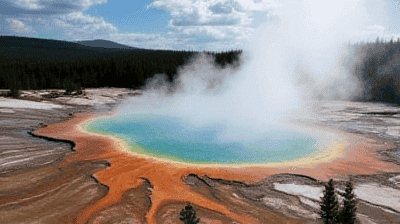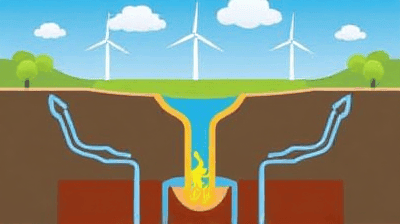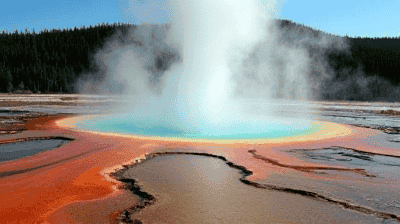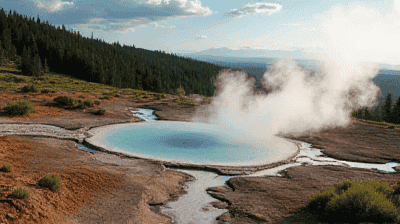
As the global community faces an urgent need to combat climate change, the quest for sustainable and renewable energy sources has intensified. While solar, wind, and hydroelectric power have received considerable attention, geothermal energy remains a promising yet underutilized resource. Tapping into the natural heat stored beneath the Earth's surface, geothermal energy offers a consistent and reliable source of power with a minimal environmental footprint.
Geothermal energy is derived from the Earth's internal heat, which originates from two primary sources: the heat remaining from the planet's formation and the decay of radioactive isotopes in the Earth's crust. This heat is stored in the form of steam and hot water in geological formations, making it accessible for energy production.
Geothermal energy can be harnessed for various applications, including:
Electricity Generation: High-temperature geothermal resources can be used to generate electricity through geothermal power plants.
Direct Use Applications: Lower-temperature geothermal heat can be used directly for heating buildings, agricultural processes, and industrial applications.
Geothermal Heat Pumps: These systems use the stable temperatures found in the shallow ground to provide heating in winter and cooling in summer for residential and commercial buildings.
Geothermal power plants typically operate in three main configurations:
Dry Steam Plants: These plants use steam directly from geothermal reservoirs to drive turbines that generate electricity. This is the oldest and simplest form of geothermal power generation.
Flash Steam Plants: In flash steam plants, high-pressure hot water from the geothermal reservoir is brought to the surface, where the pressure drops (flashing) it into steam. The steam then drives the turbines.
Binary Cycle Plants: These plants use a secondary fluid with a lower boiling point that is heated by the geothermal water. The secondary fluid vaporizes, driving the turbine while the geothermal water is returned to the reservoir.
Geothermal heat pumps (GHPs) utilize the stable temperature found in the shallow ground to efficiently heat and cool buildings. These systems consist of a ground loop filled with fluid that absorbs heat in the winter and releases it during the summer. GHPs are known for their durability and energy efficiency, often providing significant savings on heating and cooling costs.

One of the most significant advantages of geothermal energy is its low environmental impact compared to fossil fuels.
Reduced Greenhouse Gas Emissions: Geothermal power generation produces minimal greenhouse gas emissions, significantly lower than coal, oil, and natural gas. This makes it a crucial player in global efforts to mitigate climate change.
Small Land Footprint: Geothermal power plants typically require less land than other renewable energy sources, such as solar farms or wind farms. This minimizes land use conflicts and disruptions to local ecosystems.
Sustainable Resource: Geothermal energy is renewable and sustainable as long as the heat extraction is managed properly. With appropriate practices, geothermal reservoirs can provide a continuous energy supply for decades or even centuries.
Geothermal energy offers several economic advantages that can stimulate local economies:
Job Creation: The geothermal sector creates jobs in various fields, including engineering, construction, operations, and maintenance. Local communities benefit from job opportunities in both the development and ongoing operations of geothermal projects.
Stable Energy Prices: Geothermal energy provides price stability for electricity, as it is not subject to the same market fluctuations associated with fossil fuels. This predictability can be advantageous for both consumers and businesses.
Energy Independence: By harnessing domestic geothermal resources, countries can reduce their reliance on imported fuels, enhancing energy security and independence.
Geothermal energy provides a constant and reliable power source that can operate continuously, unlike other renewable energy sources that may be intermittent (e.g., solar and wind). Geothermal power plants can provide base load power, ensuring a steady supply of electricity that is essential for grid stability.
Despite its potential, geothermal energy's growth has lagged behind other renewables. However, several countries have made significant strides in harnessing this resource:
United States: The U.S. is the leader in geothermal electricity production, with notable geothermal power plants located in California, Nevada, and Utah.
Philippines: As one of the largest producers of geothermal energy globally, the Philippines relies heavily on geothermal power for its electricity needs, especially during peak demand periods.
Iceland: Iceland utilizes geothermal energy for nearly 90 percent of its heating and a significant portion of electricity generation, showcasing the resource's potential in suitable geological conditions.
Indonesia: With abundant geothermal resources, Indonesia is making considerable investments to develop its geothermal sector and expand its energy capacity.
The global geothermal energy market is expected to grow as countries explore renewable energy sources to meet climate goals. Emerging markets may include regions with significant geothermal potential, such as East Africa (Geothermal Rift Valley) and the Mediterranean.

While geothermal energy has substantial benefits, there are also challenges that can hinder its growth:
Geothermal projects often require significant upfront investments due to the costs of exploration, drilling, and infrastructure development. Securing financing can be challenging, particularly for new or smaller projects.
Geothermal resources are location-specific and primarily found in regions with volcanic activity, hot springs, or tectonic plate boundaries. This geographical limitation can make it difficult to deploy geothermal technology in areas far from these regions.
Exploring geothermal resources can be risky, as there is uncertainty about the reservoir's temperature and capacity. Failed exploration efforts can lead to wasted resources and financial loss.
Although geothermal energy has a lower environmental impact than fossil fuels, it is not without concerns. Potential issues may include land subsidence, water usage, and emissions of hydrogen sulfide gas from geothermal wells. Carefully managing these concerns is essential to ensure sustainable development.
Government policies play a crucial role in promoting geothermal energy adoption. Some essential measures include:
Incentives and Tax Credits: Offering financial incentives, such as tax credits and grants, can make geothermal projects more financially viable.
Research and Development Funding: Governments can support R&D initiatives that advance geothermal technology, exploration techniques, and efficiency improvements.
Streamlined Permitting Processes: Simplifying regulatory processes can facilitate faster approvals for geothermal projects, encouraging investment.
International collaboration can enhance geothermal energy development by sharing knowledge, technology, and best practices. Organizations and initiatives that promote geothermal energy on a global scale can drive research and awareness in countries with geothermal potential.

Innovations in drilling technology can reduce costs and increase the efficiency of geothermal exploration. Techniques such as enhanced geothermal systems (EGS) aim to create artificial reservoirs in hot rock formations, expanding geothermal potential beyond traditional resources.
EGS involves injecting water into hot, dry rock formations to create steam and generate electricity. This technology has the potential to access vast geothermal resources and bolster energy generation.
As renewable energy sources like solar and wind become more prominent, integrating geothermal energy with energy storage solutions can enhance reliability. Geothermal can serve as a foundation for hybrid systems that stabilize the grid and ensure a continuous energy supply.
Advancements in geothermal direct use applications can expand the utilization of low-temperature geothermal heat in various sectors. Innovations in district heating or geothermal heating systems for agriculture and industrial processes can increase efficiency and energy savings.
Many undiscovered geothermal resources lie beneath Earth's surface, especially in regions previously overlooked. Technological advancements in exploration and drilling can unlock these untapped resources and expand geothermal energy's potential.
Geothermal energy can complement other renewable energy sources, creating hybrid systems that maximize efficiency and reliability. Integrating geothermal with energy storage or using it alongside solar and wind can enhance overall grid performance.
Raising awareness about geothermal energy's benefits and potential is crucial for increasing its adoption. Educational initiatives targeting policymakers, businesses, and the public can foster greater understanding and support for geothermal projects.
Geothermal energy represents a powerful tool in the global fight against climate change, offering a clean, reliable, and sustainable energy source harnessed from the heat beneath our feet. With numerous advantages—ranging from reduced greenhouse gas emissions to job creation and energy independence—geothermal energy has the potential to play a significant role in the transition to a sustainable energy future.
While challenges such as high initial costs, resource location, and exploration risks need to be addressed, innovative technologies and supportive policies can help unlock geothermal energy's full potential. By investing in geothermal energy, we can move toward a future driven by renewable resources and work collectively to mitigate the impacts of climate change.
As individuals, communities, and nations strive to embrace a sustainable energy landscape, recognizing geothermal energy's potential will be essential for achieving a cleaner and greener future for generations to come.